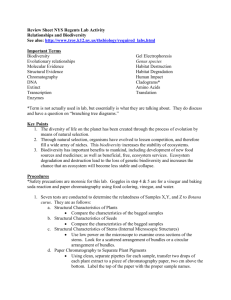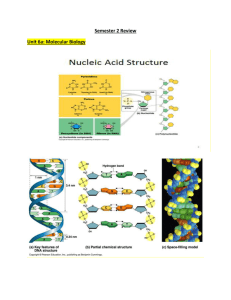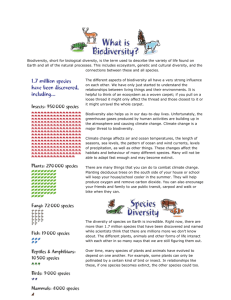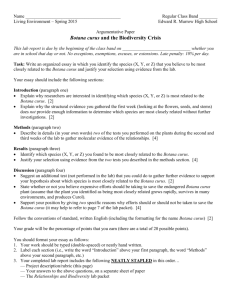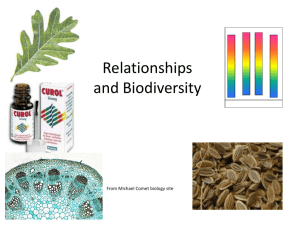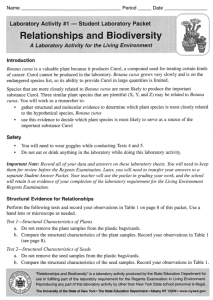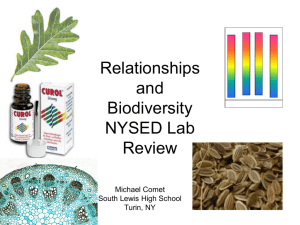Relationships and Biodiversity Lab Write up
advertisement
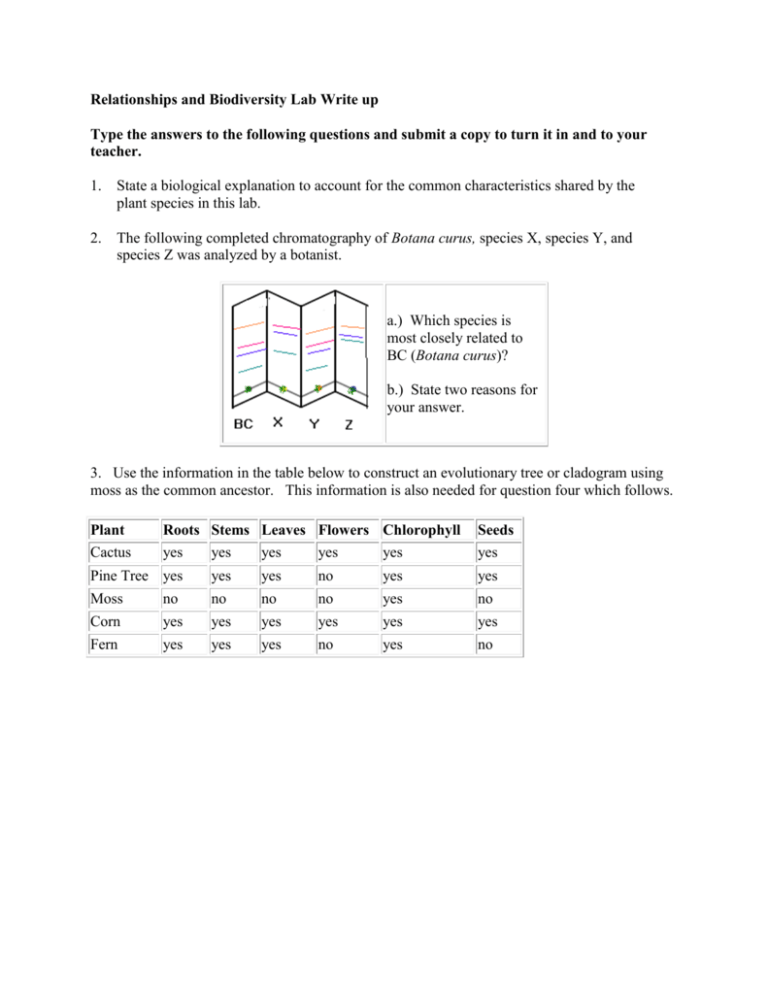
Relationships and Biodiversity Lab Write up Type the answers to the following questions and submit a copy to turn it in and to your teacher. 1. State a biological explanation to account for the common characteristics shared by the plant species in this lab. 2. The following completed chromatography of Botana curus, species X, species Y, and species Z was analyzed by a botanist. a.) Which species is most closely related to BC (Botana curus)? b.) State two reasons for your answer. 3. Use the information in the table below to construct an evolutionary tree or cladogram using moss as the common ancestor. This information is also needed for question four which follows. Plant Cactus Roots Stems Leaves Flowers Chlorophyll yes yes yes yes yes Seeds yes Pine Tree yes yes yes no yes yes Moss no no no no yes no Corn yes yes yes yes yes yes Fern yes yes yes no yes no 4. State one characteristic that would be present in the common ancestor for these five plants. 5. Plants and animals are becoming extinct at an alarming rate. Scientists are concerned about this loss of biodiversity. a.) State two ways in which human practices can maintain biodiversity. b.) Give two reasons why biodiversity should be conserved. 6. The letters shown below represent bases in a small part of a DNA molecule. Write the sequences of bases in an RNA molecule that would be produced by DNA. Remember that RNA contains U not T. DNA Base sequence T T C G C C RNA Base sequence _______________ 7. Use the genetic code chart to determine the sequence of amino acids in the protein that would result from the DNA molecule in question # 6. Amino acid sequence in protein _____________________________________ Choose the response which best completes the following statements or answers the following questions. 8. Which kind of evidence is most accurate in making decisions about relationships amongst the plant species? (1.) flower/needle color (2.) leaf/needle shape (3.) leaf pigments (4.) DNA fragment bands 9. If additional data was collected for these plant species, what should be used to provide the best evidence for relationships between the plant species? (1.) needle/flower shape (2.) distribution of stem vascular tissue (3.) other chemical indicators (4.) other DNA samples 10. Which evidence is correctly matched with the lab technique used to collect the data? (1.) enzyme present -- chromatography (2.) leaf pigments -- genetic code chart (3.) DNA fragments -- electrophoresis (4.) leaf shape -- indicator 11. To prepare the plant DNA samples of analysis, the students most likely used (1.) enzymes that recognized and cut DNA at specific base sequences (2.) indicators that chemically reacted with specific DNA base sequences (3.) microscopes to observe the specific DNA bases (4.) chromatography paper which attracts specific bases 12. Which statement is most likely to be false? (1.) Organisms with similar molecular similarities are likely to be related. (2.) In order for a species to survive for millions of years, it must contain diversity. (3.) Proteins and enzymes are produced as a result of an organisms genetic code. (4.) DNA always exists as the base pairs A --- G and C ---- T 13. Which statement is true? (1.) Amino acids are the building blocks of carbohydrates. (2.) Structural similarities provide better evidence for close relationships among organisms than molecular similarities. (3.) Increased biodiversity decreases the stability of an ecosystem. (4.) Endangered species hold medicinal, agricultural. ecological, commercial and aesthetic value. 14. As the genetic variation within a species increases, its biodiversity (1.) increases (2.) decreases (3.) remains the same 15. Define the term biodiversity. 16. List three activities by humans which could endanger plant species. 17. Why is preserving Botana curus so important? 18. List 2 reasons for not saving Botana curus from extinction. 19. The loss of biodiversity is a huge ecological problem. a.) list two human actions which may result in the loss of biodiversity b.) list two ways the loss of biodiversity can negatively effect humans c.) list one positive action humans could take to reduce the loss of biodiversity
